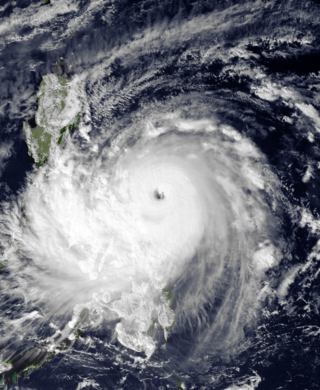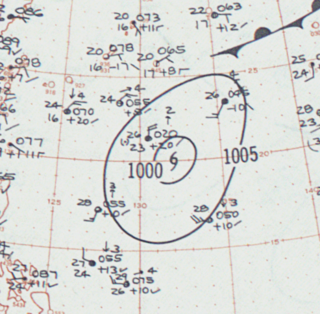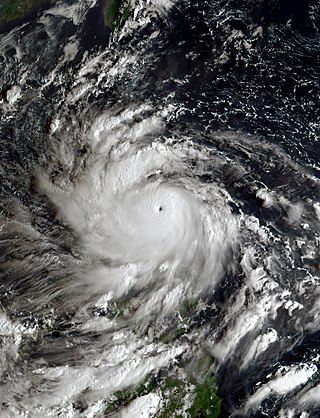
The 2000 Pacific typhoon season marked the first year using names contributed by the World Meteorological Organization. It was a rather below-average season, producing a total of 23 tropical storms, 13 typhoons and 4 intense typhoons. The season ran throughout 2000, though typically most tropical cyclones develop between May and October. The season's first named storm, Damrey, developed on May 7, while the season's last named storm, Soulik, dissipated on January 4 of the next year.

The 1964 Pacific typhoon season was the most active tropical cyclone season recorded globally, with a total of 39 tropical storms forming. It had no official bounds; it ran year-round in 1964, but most tropical cyclones tend to form in the northwestern Pacific Ocean between June and December. These dates conventionally delimit the period of each year when most tropical cyclones form in the northwestern Pacific Ocean.

Typhoon Nina, known in the Philippines as Typhoon Sisang, was the most intense typhoon to strike the Philippines since Typhoon Irma in 1981. Typhoon Nina originated from an area of convection near the Marshall Islands in mid-November 1987. It gradually became better organized, and on November 19, was first classified as a tropical cyclone. Moving west-northwest, Nina attained tropical storm intensity that evening. Late on November 20, Nina passed through the Chuuk Lagoon in the Federated States of Micronesia. After a brief pause in intensification, Nina intensified into a typhoon on November 22. Two days later, the typhoon intensified suddenly, before attaining its peak 10 minute intensity of 165 km/h. During the afternoon of November 25, Nina moved ashore in Southern Luzon at the same intensity. It gradually weakened over land, before entering the South China Sea and turning to the north. By November 30, Nina dissipated.

Typhoon Babs, known in the Philippines as Typhoon Loleng, was a powerful typhoon that struck the Philippines days after Typhoon Zeb hit the same area. The seventh typhoon of the inactive 1998 Pacific typhoon season, Babs formed on October 14 between the Philippines and Guam. The storm moved westward initially, failing to intensify initially due to the outflow from Typhoon Zeb to the northwest. Babs slowed and briefly turned to the south before advancing to the northwest, whereupon it rapidly intensified into a strong typhoon. On October 20, the official Japan Meteorological Agency (JMA) estimated peak 10‑minute winds of 155 km/h (96 mph), while the unofficial Joint Typhoon Warning Center (JTWC) estimated peak 1‑minute winds of 250 km/h (160 mph), making Babs an unofficial super typhoon. The storm struck the Philippine island of Catanduanes at that intensity and weakened slightly before hitting Luzon. Babs turned northward once in the South China Sea, later weakening due to unfavorable conditions and transitioning into an extratropical cyclone on October 27 in the Taiwan Strait.

Typhoon Irma, known in the Philippines as Typhoon Anding, was a powerful typhoon that struck the Philippines in November 1981. The twenty-fifth named storm and fourteenth typhoon of the 1981 Pacific typhoon season, Irma originated from an active monsoon trough to the east of the Philippines. Following an increase in organization, the system was first classified on November 18 and was subsequently upgraded into a tropical storm on the next day as it moved westward. After passing near Guam, Irma continued to deepen, and was estimated to have attained typhoon intensity early on November 21. The intensification rate accelerated thereafter, and on the afternoon of November 22, Irma reached its peak wind speed of 205 km/h (125 mph). After maintaining this intensity for 16 hours, Irma weakened considerably due to interaction with the mountainous terrain of the Philippines. On the morning of November 24, Irma moved ashore northeast of Manila, with winds of 165 km/h (105 mph). The storm rapidly deteriorated overland, but was still believed to have been a typhoon when it emerged into the South China Sea. Irma then began to re-curve towards the northwest while weakening; the cyclone was estimated to have obtained extratropical characteristics on November 26.

Typhoon Xangsane, known in the Philippines as Typhoon Milenyo, was a typhoon that affected the Philippines, Vietnam, and Thailand during the 2006 Pacific typhoon season. The name Xangsane was submitted by Laos and means elephant.

Severe Tropical Storm Halong, known in the Philippines as Typhoon Cosme, was the fourth severe tropical storm named by the Japan Meteorological Agency (JMA), which is the Regional Specialized Meteorological Centre for the Northwestern Pacific Ocean. The Joint Typhoon Warning Center also recognized Halong as the fifth tropical depression, the fourth tropical storm, as well as the third typhoon of the 2008 Pacific typhoon season.

Typhoon Ketsana, known in the Philippines as Tropical Storm Ondoy, was the second-most devastating tropical cyclone of the 2009 Pacific typhoon season, causing $1.15 billion in damages and 665 fatalities, only behind Morakot earlier in the season, which caused 789 deaths and damages worth $6.2 billion. Ketsana was the sixteenth tropical storm, and the eighth typhoon of the season. It was the most devastating tropical cyclone to hit Manila, surpassing Typhoon Patsy (Yoling) in 1970.

Typhoon Nalgae, known in the Philippines as Typhoon Quiel, was a powerful tropical cyclone that struck the Philippines, and it affected Hainan, China as a weak tropical storm. Nalgae was the eighth typhoon and the fourth super typhoon in 2011. Forming as the 32nd tropical depression of the season, the system formed on September 26 over the Philippine Sea. On September 27, it was named Nalgae as it explosively intensified into a typhoon on the next day. Nalgae reached its peak intensity as a Category 4 typhoon on September 30 while it made landfall over Luzon. Nalgae weakened into a tropical storm as it entered the South China Sea on October 1. Nalgae made landfall over the island of Guandong in China on October 4 as it weakened to a tropical depression. Nalgae dissipated on October 5 east of Vietnam.

Typhoon Gordon, known in the Philippines as Typhoon Goring, was a powerful tropical cyclone that caused widespread damage and loss of life in the Philippines and Southern China in July 1989. Gordon developed into a tropical depression near the Northern Mariana Islands on July 9 and quickly intensified as it tracked west-southwestward. On July 13, the storm attained typhoon status and subsequently underwent a period of rapid intensification. By July 15, the storm attained its peak strength as a Category 5 equivalent super typhoon with winds estimated at 260 km/h (160 mph). After striking the northern Philippines, Gordon moved through the South China Sea and slowly weakened. On July 18, the storm made landfall in southern China and was last noted the following day as it dissipated over land.

Tropical Storm Lucille was the first tropical cyclone to have its name retired in the Western Pacific basin. Lucille was identified as a weak tropical depression on May 25, 1960, to the east of the Philippines. Tracking northwestward, the system failed to develop and warnings on it were discontinued on May 27. At the same time, a second system began organizing along the west coast of Luzon. The two systems ultimately merged into one over the Philippines between May 28 and 29. Now tracking northeastward, the system re-intensified and became a tropical storm on May 30. Lucille attained its peak intensity later that day with winds of 85 km/h (53 mph). As it accelerated over open waters, the system brushed the islands of Iwo Jima and Chichi-jima before transitioning into an extratropical cyclone on June 1. The remnants of Lucille were last noted on June 4 near the International Date Line.

Tropical Storm Rumbia, known in the Philippines as Tropical Storm Toyang, brought deadly flooding to the central and southern Philippines in November and December 2000. The last of three consecutive tropical cyclones of at least tropical storm intensity to strike the Philippines, Rumbia began as a tropical depression on November 27, gradually intensifying to reach tropical storm intensity the next day. Strengthening later stagnated, and Rumbia would weaken back to depression status as it made landfall on the central Philippines on December 1. Though the Japan Meteorological Agency (JMA) determined Rumbia to have dissipated on December 2, the Joint Typhoon Warning Center (JTWC) continued to monitor the system over the next few days as it tracked across the South China Sea. For a period of time beginning on December 5, Rumbia reorganized and strengthened back to tropical storm intensity before wind shear began to weaken the system. Located south of Vietnam on December 7, the storm's circulation center became devoid of convection, and by then Rumbia was declared by the JTWC to have dissipated.

The effects of the 2013 Pacific typhoon season in the Philippines were considered some of the worst in decades. Throughout the year, a series of typhoons impacted the country, with the worst impacts coming from Typhoon Haiyan, especially in death toll, during November.

Typhoon Cary, known as Typhoon Ising in the Philippines, was the second of two tropical cyclones to affect Vietnam in a week. An area of disturbed weather developed southwest of Pohnpei on August 6, 1987. The system initially remained disorganized, but by August 14, Cary had attained tropical storm intensity. After initially moving north-northwest, Cary turned west-northwest, although intensification was slow to occur. On August 15, Cary was upgraded into a typhoon, and on August 17, the typhoon peaked in intensity. Typhoon Cary then made landfall in northern Luzon while at peak intensity. Across the Philippines, 954 houses were damaged and an additional 89 were destroyed, which left 55,567 people, or 13,247 families that were either homeless or otherwise sought shelter. Five people died in the country while damage totaled $5.58 million (1987 USD), including $1.45 million from agriculture and $4.13 million from infrastructure. The storm weakened over land, but re-intensified into a typhoon over the South China Sea. On August 21, Typhoon Cary passed just south of Hainan, where hundreds of homes were damaged but no fatalities occurred, and subsequently entered the Gulf of Tonkin. The storm weakened as it approached Vietnam, and on August 23, the storm dissipated inland over Laos. Across Vietnam, almost 40,000 ha of land were flooded or destroyed. Twenty people were killed and many others were injured.

Typhoon Phanfone, known in the Philippines as Typhoon Ursula, was a strong and deadly tropical cyclone which traversed the Philippines on Christmas Eve and Christmas Day in 2019, the first typhoon to do so since Nock-ten in 2016.

Tropical Storm Sarika, known in the Philippines as Tropical Storm Dodong, was a weak but costly tropical storm that affected Philippines and the East China in early-June 2011. The sixth tropical depression and the third named storm of the 2011 Pacific typhoon season, Sarika formed from an area of low pressure near Cebu City. As it traversed the Verde Island Passage on June 8, both the JTWC and the JMA started issuing advisories on the system, with the former issuing a TCFA on the system later that day. The next day, the PAGASA upgraded the low-pressure area to a tropical depression, naming it Dodong. Moving to the north, the system struggled to intensify due to strong wind shear and was downgraded by the JTWC to a tropical depression; however, the JMA kept the system as a minimal tropical storm until it made landfall near Shantou on June 11. It dissipated soon thereafter.

Typhoon Flo, known in the Philippines as Typhoon Kadiang, was a catastrophic and deadly minimal typhoon that hit the northern Philippines during October 1993. It also caused the largest 72-hour forecast error for the year due to its interaction with the nearby Super Typhoon Ed. The twenty-seventh depression, twenty-second named storm and the eleventh typhoon of the 1993 Pacific typhoon season, Flo originated from an area of convection that was embedded from a monsoon trough during September 28. Two days later, a tropical depression formed within this trough, to the west of Guam. Slowly organizing, it remained a tropical depression until on October 2, when it strengthened to a tropical storm and was given the name Flo by the Japan Meteorological Agency. Slight wind shear from nearby Ed inhibited development; however, it intensified to a minimal typhoon as it neared the coastline of Luzon. On October 3, it made landfall near the Isabela-Aurora in its peak. It then crossed the country while weakening, and moved ashore near the South China Sea the next morning. It then unexpectedly moved back to the country due to its interaction with Ed, and it moved back to the Philippine Sea on October 17 before accelerating to the south of Japan. It then became extratropical on the next day.

Typhoon Noru, known in the Philippines as Super Typhoon Karding, was an intense and destructive tropical cyclone that affected Vietnam, Thailand, and the Philippines — where it caused widespread agricultural damage. Noru, which means Roe deer in Korean, the sixteenth named storm and eighth typhoon, and third super typhoon of the 2022 Pacific typhoon season, Noru originated from a disturbance over the Philippine Sea, slowly tracking eastward until its development into a tropical depression, where it began to move westward.

Typhoon Trix was a devastating and deadly tropical cyclone of the 1952 Pacific typhoon season that severely impacted the Philippines and also affected the coast of Indochina, particularly Vietnam. As the eighteenth storm and twelfth typhoon of the season, Trix formed on October 15 as a tropical depression over Micronesia, being first tracked by the Joint Typhoon Warning Center (JTWC). Trix slowly strengthened as it moved westwards, before it rapidly intensified as it neared the Philippines. Slight weakening took place before the system passed over the country before restrengthening in the South China Sea. There, Trix degraded again for the second time and moved over Vietnam as a tropical storm before dissipating over Thailand.

Severe Tropical Storm Nalgae, known in the Philippines as Severe Tropical Storm Paeng, was a very large and deadly tropical cyclone that wreaked havoc across the Philippines and later impacted Hong Kong and Macau. Nalgae, meaning wing in Korean, the twenty-second named storm of the 2022 Pacific typhoon season, Nalgae originated from an invest located east of the Philippines on October 26. The disturbance, initially designated as 93W, was eventually upgraded the following day to a tropical depression by the Joint Typhoon Warning Center (JTWC) and re-designated as 26W. The Japan Meteorological Agency (JMA) however, had already considered the disturbance as a tropical depression a day prior to JTWC's; the Philippine Atmospheric, Geophysical and Astronomical Services Administration (PAGASA) also followed the JMA's lead and gave it the name Paeng. That same day, it was upgraded again by the JMA to tropical storm status, thus gaining the name Nalgae. The next day, the PAGASA and the JTWC upgraded Nalgae to a severe tropical storm status on October 28. Nalgae would eventually made its first landfall in Virac, Catanduanes, which was quickly followed by another landfall thirty minutes later. It then traversed the Bicol Region and emerged into Ragay Gulf, eventually making another landfall. Defying initial forecasts, Nalgae then moved southwestward and struck Mogpog. Afterwards, the storm moved northwestward into the Sibuyan Sea and struck Sariaya. Then it would move through many regions throughout the evening of October 29. Nalgae emerged over the West Philippine Sea the next day and weakened below tropical storm status. The storm would later re-intensify into a severe tropical storm a few hours later, and eventually exited the Philippine Area of Responsibility a day later. Upon its exit from Philippine jurisdiction, Nalgae then intensified into a Category 1-equivalent typhoon on JTWC; however, the JMA maintained its severe tropical storm classification for the system. It then approached the Pearl River Delta. At around 04:50 CST on November 3, 2022, Nalgae made its final landfall at Xiangzhou District as a tropical depression.






















